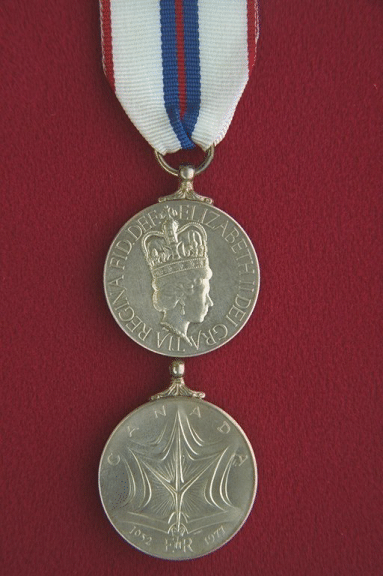Queen Elizabeth II Silver Jubilee Medal (1977)
Description
Context
The medal was instituted on 06 February 1977, with most awards made in the same year.
Eligibility and Criteria
In order that the list of those to be honoured would be representative of all the regions of Canada, agencies of government at the federal, provincial, and local levels were invited to propose the names of candidates for the medal. National organizations in every important field of endeavor, including the professions, education and arts, veterans' groups, sports associations, philanthropic and charitable bodies and welfare services were asked to participate in submitting nominations. All members of the Order of Canada, Order of Military Merit and winners of the Canadian Bravery Decorations received the medal. Selection for the Armed Forces was based on merit with length of service and prestige of current appointment as secondary consideration.
Description
The circular silver medal, 1.25 inches in diameter, has a thin, smooth raised rim. The Canadian issue was slightly thicker than the British issue. For mounting purposes, there is a silver ring, which holds the ribbon, passes through a small hollow ball at the top of a claw joined to the top of the medal.
The obverse shows Queen Elizabeth II, facing right, wearing the high Imperial State Crown. The inscription around the rim reads: ELIZABETH II DEI GRATIA REGINA FID DEF.
On the Canadian medal the reverse shows a large stylized maple leaf with CANADA around the top rim and 1952 EIIR 1977 in small lettering around the bottom of the rim. The EIIR has a small crown on top. In very small letters above and between the EIIR and 1977 is the word HUNT in honour of the designer of the medal Dora de Pédery-Hunt.
Historical Notes
- For the Canadian version there were 30,000 medals issued, including 7,000 to the Canadian Forces, 5,500 to the regular force and 1,500 to the reserve forces. The regular force breakdown of medals was 1,500 to officers (all general officers; 50% of Colonels; 25%LCols; 20% Majors; 5% Captains; & 5% Lieutenants or equivalent naval ranks) and 4,000 to other ranks (50% CWOs; 25% MWOs; 15% WOs; 5% Sergeants; 5% Master Corporals; and 5% Corporals). The reserve force awards were made on a proportionate strength basis to the land, sea and air components, the Cadet Instructors List, the Canadian Rangers and to those holding honourary appointments. The Commanding Officer of each unit decided who in the unit would receive medals.
